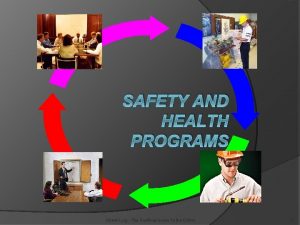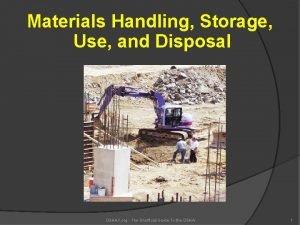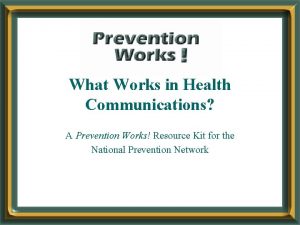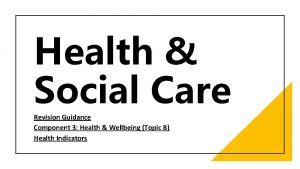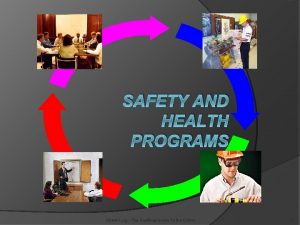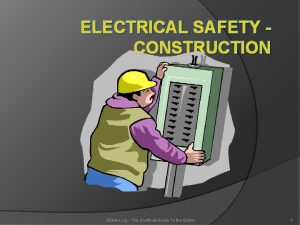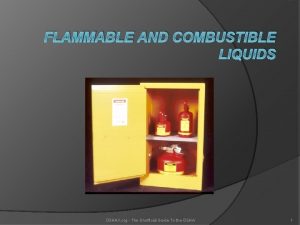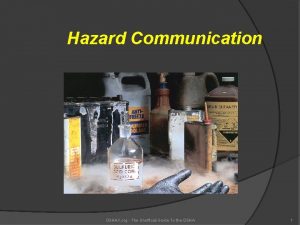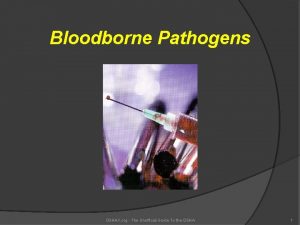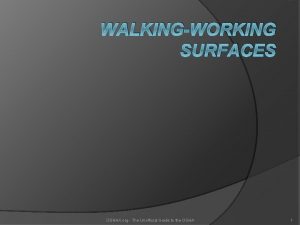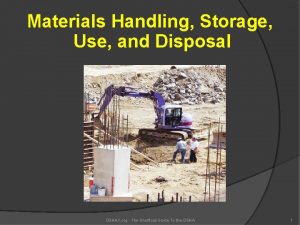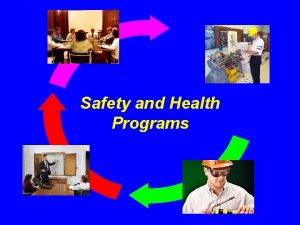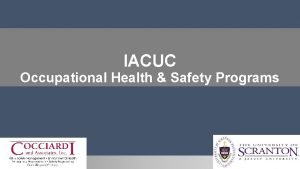SAFETY AND HEALTH PROGRAMS OSHAX org The Unofficial



















- Slides: 19

SAFETY AND HEALTH PROGRAMS OSHAX. org - The Unofficial Guide To the OSHA 1

Benefits of Effective Safety and Health Programs • Reduce work related injuries and illnesses • Improve morale and productivity • Reduce workers’ compensation costs OSHAX. org - The Unofficial Guide To the OSHA 2

Major Elements An effective occupational safety and health program includes the following four elements: Ø Management commitment and employee involvement Ø Worksite analysis Ø Hazard prevention and control Ø Safety and health training OSHAX. org - The Unofficial Guide To the OSHA 3

Management Commitment and Employee Involvement These are complementary elements • Management commitment provides motivation and resources • Employee involvement allows workers to develop and express commitment to safety and health • OSHAX. org - The Unofficial Guide To the OSHA 4

Policy and Goals Clearly state a worksite safety and health policy • Establish and communicate a clear goal and objective for the safety and health program • Involve top management in implementing the program • OSHAX. org - The Unofficial Guide To the OSHA 5

Employee Involvement Encourage employees to get involved in the program and in decisions that affect their safety and health • Communicate responsibility for all program aspects • OSHAX. org - The Unofficial Guide To the OSHA 6

Responsibility Parties responsible for the safety and health program must have authority and resources • Managers, supervisors, and employees must be held accountable for meeting their responsibilities • Program operations must be reviewed at least annually, to evaluate, identify deficiencies, and revise, as needed • OSHAX. org - The Unofficial Guide To the OSHA 7

Worksite Analysis Examine the worksite and identify: -- existing hazards -- conditions and operations where changes might occur to create hazards • Management must actively analyze the work and the worksite to anticipate and prevent harmful occurrences • OSHAX. org - The Unofficial Guide To the OSHA 8

Comprehensive Survey • Conduct a comprehensive baseline survey for safety and health • Job Hazard Analysis • Who may help you: -- OSHA Consultation Program -- Insurance companies -- Consultants OSHAX. org - The Unofficial Guide To the OSHA 9

Safety and Health Inspections Conduct regular (usually weekly) site inspections • Establish daily work area inspection procedures • Develop and use a checklist • Provide a reliable system for employees, without fear of reprisal, to notify management about apparent hazardous conditions and to receive timely and appropriate responses • OSHAX. org - The Unofficial Guide To the OSHA 10

Additional Worksite Analysis Investigate accidents and “near miss” incidents, so that their causes and means for prevention are identified • Analyze injury and illness trends, so that common cause patterns can be identified and prevented • OSHAX. org - The Unofficial Guide To the OSHA 11

Hazard Prevention and Control Start by determining that a hazard or potential hazard exists • Where feasible, prevent hazards by effective design of job or job site • If the hazard cannot be eliminated, use hazard controls • Eliminate or control hazards in a timely manner • OSHAX. org - The Unofficial Guide To the OSHA 12

Controlling the Hazards To prevent and control hazards: Engineering controls Administrative controls Personal protective equipment Safe work practices communicated via training, positive reinforcement, correction of unsafe performance, and enforcement OSHAX. org - The Unofficial Guide To the OSHA 13

Hazard Prevention Planning Maintain the facility and equipment • Emergency planning Ø Training and drills, as needed • Medical program Ø First aid on site Ø Physician and emergency care nearby • OSHAX. org - The Unofficial Guide To the OSHA 14

Safety and Health Training Address the safety and health responsibilities of all personnel • Incorporate it into other training and job performance/practice • OSHAX. org - The Unofficial Guide To the OSHA 15

Safety and Health Orientation Employees must understand the hazards they may be exposed to and how to prevent harm to themselves and others from hazard exposure Orientation training must be given to site and contract workers OSHAX. org - The Unofficial Guide To the OSHA 16

Supervisor Responsibilities • Analyze work to identify potential hazards in area of responsibility • Maintain physical protections in work areas • Reinforce employee training through performance feedback and, if needed, enforcement of safe work practices OSHAX. org - The Unofficial Guide To the OSHA 17

Specific Training Needs • Hazard recognition • • Training required in standards Emergency response Accident investigation Emergency drills OSHAX. org - The Unofficial Guide To the OSHA 18

Summary Effective worker safety and health programs: • Reduce work related injuries and illnesses • Improve morale and productivity • Reduce workers’ compensation costs • Include these four elements: Ø Management commitment and employee involvement Ø Worksite analysis Ø Hazard prevention and control Ø Safety and health training OSHAX. org - The Unofficial Guide To the OSHA 19
 Oshax
Oshax Oshax
Oshax Oshax
Oshax Oshax
Oshax National programme related to child health and welfare ppt
National programme related to child health and welfare ppt Cpmcd full form
Cpmcd full form Jmu pre pt
Jmu pre pt Gtcc unofficial transcript
Gtcc unofficial transcript Cwu unofficial transcript
Cwu unofficial transcript Presporous
Presporous Types of formal communication
Types of formal communication Myaccess uh
Myaccess uh Indiana health coverage programs
Indiana health coverage programs Doh health programs
Doh health programs Community health education outreach programs
Community health education outreach programs Making health communication programs work
Making health communication programs work Health and social care component 3
Health and social care component 3 Hình ảnh bộ gõ cơ thể búng tay
Hình ảnh bộ gõ cơ thể búng tay Frameset trong html5
Frameset trong html5 Bổ thể
Bổ thể
